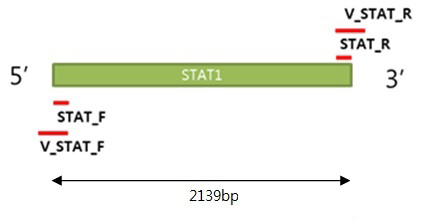Team:KAIST-Korea/Parts/Characteristics
From 2010.igem.org
|
Characteristics
STAT1STAT1 (Signal Transducer & Activator of Transcription) is one of members of STAT family. Proteins of these family regulate gene expression depending on their level of phosphorylation. High phosphorylation improves STAT1's ability to bind GAS element of promoter and makes STAT1 to activate gene more strongly. STAT1 is phosphorylated by many protein kinases, such as JAK(Janus Kinase) family. For our project, we used FGFR's kinase domain for phosphorylation. Dimerization of FGFR turns on kinase catalytic activity of FGFR. So STAT1 acts as signal Transducer. Therefore, STAT1 is the signal-linking protein between surface FGFR and nuclear GAS element
Antigen Receptor for M.tuberculosis MPT51 antigenOur Antigen Receptor is based on FGFR1 protein which is receptor Fibroblast Growth Factor. FGFR1 has Ig(immuno-globulin)-like sequence at its growth factor binding domain. It means that FGFR1 cognize FGF with antibody-antigen manner. So if we substitute FGFR1's FGF binding domain with certain antigen binding domain, it will cognize that antigen what we intended. But our FGFR1 protein is for human leukocyte membrane, while our expression organism is fission yeast. Therefore, we replace signal peptide for FGFR1. This protein is consist of three parts; front constant part, variable (antigen-binding )part, and back constant region. Each parts have differnt function for antigen cognition of Antigen Receptor. And functions of each parts are described in following sections.
Front Constant Part of Antigen ReceptorFront constant part of antigen receptor is subsequence of Antigen Receptor. Its function is to localize Antigen receptor at surface of fission yeast and to make place for antigen binding parts of antigen receptor. Front constant part consists of signal peptide sequence for fission yeast surface and Ig-like sequence 1. signal peptide is the small peptide sequence which localize protein at translation time. Though Ig-liek sequence 1 is ig-like sequence, it doesn't bind to FGF directly. So we leave this sequence and place in the front constant part. Signal peptide for fission yeast cell surface is from 'Cell wall integrity and stress response component 1'. and Ig-like sequence 1 is from normal human FGFR1. If you want to present our antigen receptor at other organism, you just replace this sequence for signal peptide with sequence for your signal peptide. Variable Part of Antigen Receptor for Mycobacterium tuberculosis MPT51 antigenVariable Parts of antigen receptor is antigen-binding region of antigen receptor. Basically, this region is a 'single chain antibody' which is single chain protein which can bind to the antigen and consists of two variable regions of original antibodies and a liking sequence. We used sequence of 16a1 antibody which binds to the MPT51 antigen of Mycobacterium tuberculosis, and GGGGSGGGGS polypeptide for our linker sequence. If you want to make antigen receptor for other antigen, you just replace this antigen binding sequence for MTP51 antigen with sequence for your antibody in single chain antibody manner. Back Constant Part of Antigen ReceptorBack constant part of antigen receptor is subsequence of antigen receptor. Its function is to phosphorylate STAT1 protein when antigen binds to the receptor. And phosphorylation of STAT1 activate the gene whose promoter contain GAS element. You don't need to replace this part with other sequence. Because this part have very constant function while front constant part should be changed when it is expressed on different cell and variable part should be changed when it should cognize other antigen. GFP with GAS-included promoterThis sequence have three subsequences; proximal promoter which contain GAS element, core promoter, and gene for GFP protein. Before description of this brick, we need to describe about the structure of promoter. Promoter is consist of core promoter for basic protein like TBP(TATA box Binding Protein), RNA Polymerase and other General Transcription Factors, proximal promoter which have specific transcription factor binding site, and distal promoter who also influence gene regualtion. GAS element which is binding site of STAT1 dimer is located in proximal promoter. So we added GAS element containing proximal promoter sequence to the core promoter and GFP gene sequence from PREP21(+GFP) plasmid. |
 "
"

